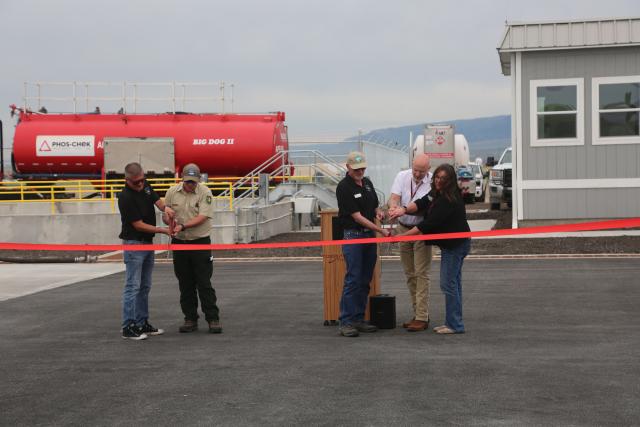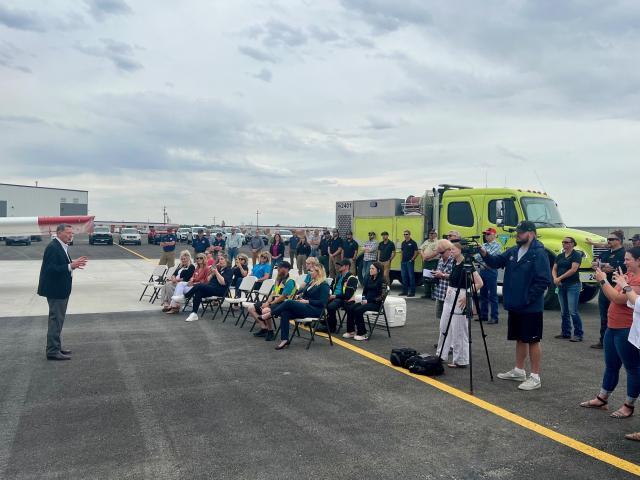You are viewing ARCHIVED content published online before January 20, 2025. Please note that this content is NOT UPDATED, and links may not work. Additionally, any previously issued diversity, equity, inclusion or gender-related guidance on this webpage should be considered rescinded. For current information, visit https://www.blm.gov/blog.
BLM Wyoming bolsters aerial firefighting capabilities with new Casper Airtanker Base

After several years of operating from a makeshift one-acre base – complete with surplus FEMA trailer, camp trailer, portable retardant tanks, and porta-potties – a modernized, permanent airtanker base to support aerial wildland firefighting in the region has become a reality for the Bureau of Land Management’s High Plains District in Casper, Wyo.
Local, state, and federal partners gathered on June 14 to celebrate the grand opening of the newly constructed Casper Airtanker Base, located at the Casper-Natrona County International Airport (CNCIA).

“We see longer seasons, larger, more destructive fires that drastically damage watersheds, ecosystems, critical species and infrastructure, as well as threaten our communities, and often, the livelihoods of many families,” Craig Short, BLM High Plains District Fire Management Officer, told guests during his commencement speech for the ceremony. “The new facility will provide support at the national and regional levels, as well as to our local communities here in Wyoming, regardless of ownership and jurisdiction.”
The CNCIA became home to two exclusive-use Single Engine Airtankers (SEAT) funded by the Wyoming State Forestry Division (WSFD) in 2020. Prior to then, portable tanker bases could be stood up at the airport during times of need. Since 2020, this ongoing collaboration between the BLM and the WSFD has offered consistent, rapid initial attack against wildfires regardless of jurisdiction and at no cost to the benefitting agency for the first operational period.
Over the four years the WSFD-contracted SEATS operated out of Casper, the aircraft flew an average of 152 missions per year and dropped an average of 95,000 gallons of retardant.
Also, around the 2020 timeframe, an emphasis at the national level to modernize and upgrade existing SEAT bases across the BLM led the High Plains District to start the process of developing a permanent facility. Short, as well as many others behind the scenes, got to work tracking down funding and designing the base. Key to the success of the base was the collaborative efforts of CNCIA Director Glenn Januska, who helped take the facility from idea to fully operational tanker base.

Clark Hammond, U.S. Forest Service Rocky Mountain Regional Aviation Officer, saw an opportunity after hearing the BLM’s plans to build what was to be a SEAT base. In his remarks at the ceremony, Hammond described Wyoming as a hole needing filled in terms of aerial firefighting resources. While the Cowboy State is catching up with two relatively new, permanent SEAT bases in Rock Springs and Worland, it had lacked a permanent place to consistently base Large Airtankers (LAT).
Hammond crunched the numbers in his efforts to get the Forest Service on board with the base’s construction. What he found was an estimated $20 million cost savings to the American taxpayer over the next ten years by building a permanent LAT base, as opposed to continuing to stand up portable LAT bases.
The financial aspect, as well as the need for greater aerial resources in Wyoming, led the Forest Service to include an additional $2 million to BLM’s $4 million in funding. Through the Forest Service’s contribution, the airtanker base transformed into Wyoming’s only LAT base, joining a roster of LAT bases in surrounding states, including South Dakota, Montana, Idaho, and Colorado.
Since opening the facility June 14 and the SEATs coming online shortly after, the base and aircraft it houses wasted no time in showing their utility. By June 28, the SEATs had already flown 14 missions. To date, the SEATs have supported more than 20 individual fires in Wyoming, Nebraska, and Montana, delivering over 60,000 gallons of retardant. In mid-July, the facility officially came online as a LAT base, welcoming two LATs to assist suppression efforts on the Oregon Trail Fire west of Casper.

“I am proud of this exceptional new facility and even more proud of the partners the BLM had the honor of working with to make this base a reality" - Kevin Christensen, BLM High Plains District Manager.
Base Specifications
| Casper SEAT Base (former) | Casper Airtanker Base (new) |
|---|---|
|
|
|
|
|
|
|
|
|
|
|
|
|
|
|
|
|
Tyson Finnicum, Public Affairs Specialist
Related Stories
- 11-year-old Touren Pope discovers ancient turtle fossil on BLM land in Wyoming
- Progress on Public Lands: BLM 2025 Trump Administration Accomplishments | January 20 - December 31, 2025
- Rural wildland firefighting partners grateful for BLM gift
- BLM Fire Team brings Smokey Bear to Kingman’s Street of Lights
- BLM hosts fire investigation training course to strengthen wildland fire investigation capacity across Arizona and the West
